Crested gecko
| Crested gecko | |
|---|---|
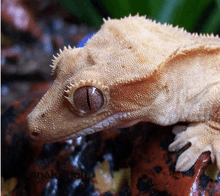 | |
| Scientific classification | |
| Kingdom: | Animalia |
| Phylum: | Chordata |
| Class: | Reptilia |
| Order: | Squamata |
| Family: | Diplodactylidae |
| Genus: | Correlophus |
| Species: | C. ciliatus |
| Binomial name | |
| Correlophus ciliatus Guichenot, 1866 | |
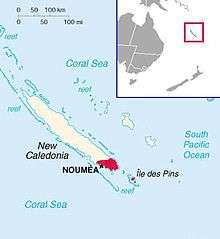 | |
| Approximate distribution of the crested gecko | |
| Synonyms | |
| |
The crested gecko (Correlophus ciliatus) is a species of gecko native to southern New Caledonia. In 1866, the crested gecko was discovered by a French zoologist named Alphone Guichenot, who is also credited with naming the species.[2] This species was thought extinct until it was rediscovered in 1994 during an expedition led by Robert Seipp.[3][4] Along with several Rhacodactylus species, it is being considered for protected status by the Convention on the International Trade in Endangered Species of Wild Flora and Fauna. It is popular in the pet trade.
Taxonomy
The species was first described in 1866 as Correlophus ciliatus by the French zoologist Alphone Guichenot in an article entitled "Notice sur un nouveau genre de sauriens de la famille des geckotiens du Muséum de Paris" ("Notes on a new species of lizard in the gecko family") in the Mémoires de la Société Scientifique Naturelle de Chérbourg. It was later renamed Rhacodactylus ciliatus. Recent phylogenetic analysis indicates that R. ciliatus and R. sarasinorum are not closely related to the other giant geckos, so these two species have been moved back to the genus Correlophus.[5]
The specific name, ciliatus, is Latin, from cilia ("fringe" or "eyelashes") and refers to the crest of skin over the animal's eyes that resembles eyelashes.
Physical description
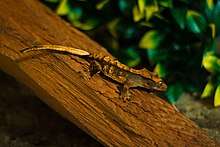
Crested geckos are among the largest gecko species and typically range from 6–10 inches (15–25 cm) in length, including 4–6 inches (10–15 cm) of tail length.[3] Among the most distinctive features of these geckos are the hair-like projections found above the eyes, which greatly resemble eyelashes. Crested geckos also have two rows of spines that run from the sides of their wedge-shaped head to the base of their tail. Crested geckos do not have eyelids and so they use their long tongues to moisten their eyes and remove debris. The toes and the tip of the semi-prehensile tail are covered in small hairs called setae. Each seta is divided into hundreds of smaller (approximately 200 nanometres in diameter) hairs called spatulae. It is believed these structures exploit the weak van der Waals force to help the gecko climb on most solid surfaces. The toes have small claws which aid in climbing surfaces to which their toes cannot cling. They possess a semi-prehensile tail which they use to assist in climbing. The tail can be dropped (via caudal autotomy) as a deterrent to predators. Unlike some other geckos, once they lose their tail, it will not grow back; however, this is not as harmful to the gecko as it is in other species, such as the leopard gecko, which store fat reserves in their tails.[6] In fact, most adults in the wild lack tails.[4]
The crested gecko has many naturally occurring color groups, including grey, brown, red, orange, and yellow of various shades. They have three color morphs in the wild, which include pattern-less, white-fringed, and tiger. Breeders of the species have achieved many other patterns such as the extreme harlequin pattern that are not observed in the wild.[7]
The crested gecko has distinct structural morphs in head size and crest abundance. Geckos with a head length less than 1.3 times its width are considered "crowned". The numbers and sizes of crests can vary; some geckos have crests that extend to the base of the tail and some lack crests on one side of their body.
Geographic distribution
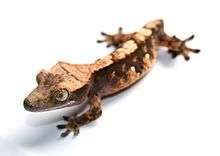
The crested gecko is endemic to South Province, New Caledonia. There are three disjunct populations, one found on the Isle of Pines and surrounding islets, and there are two populations found on the main island of Grande Terre. One population is around the Blue River, which is a protected provincial park, and the other is further north, just south of Mount Dzumac.
Ecology and behavior
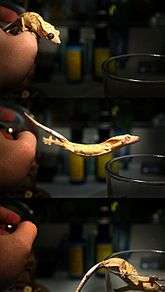

Crested geckos do not have eyelids. Instead, a transparent scale, or spectacle, keeps each eye moist, and the geckos use their tongues to clear away debris. Like the closely related Rhacodactylus geckos, crested geckos have webbed legs and digits. They are a mostly arboreal species, preferring to inhabit the canopy of the New Caledonian rainforests, and because of this they can jump considerably well. They are primarily nocturnal, and will generally spend the daylight hours sleeping in secure spots in high branches. Crested geckos are, however, less strong climbers than Tokay Gecko species.
Crested geckos shed their skin up to once a week when young. When fully grow, the process only occurs once every one or two months.[8]
The crested gecko – unlike the closely related gargoyle gecko (Rhacodactylus auriculatus) – will not regrow its tail once lost.[6] The cells around the base of the tail are brittle, allowing the tail to break away when threatened or caught by a predator. The capillaries to the tail will close almost instantly, so there is little to no blood loss. The tails will move independently of the body for 2–5 minutes. The loss of their tail is not problematic, and most adults in the wild do not have their tails.
Unlike most species of gecko, this species is an omnivore, also considered frugivorous, feeding on a variety of insects and fruit.[6] In captivity, they should be fed a commercially prepared, fruit-based diet with live feeder insects as a supplement. An unbalanced diet containing insufficient calcium can quickly lead to metabolic bone disease (MBD).
Captivity
Though the export of wild crested geckos is now prohibited, biologists exported several specimens for breeding and study before New Caledonia stopped issuing permits to export the species. From these specimens, different breeding lines were established both in Europe and the United States. The crested gecko is now one of the most widely kept and bred species of gecko in the world.[6]
These geckos can be very long-lived. While they have not been kept in captivity long enough for a definitive life span determination, they have been kept for 15–20 years or more.[8] They can be kept healthy on specially prepared diets with sufficient calcium and other nutrients.
Reproduction
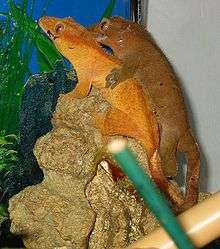
Little is known about the wild reproductive behavior of crested geckos, but in captivity they breed readily, with the female laying two eggs, which hatch 60–150 days after they are laid. Eggs are generally laid at four week intervals as long as the fat and calcium reserves of the female are still at healthy levels. Crested geckos have two small sacs for calcium on the roof of their mouths. If an egg-laying female does not have enough calcium her sac will be depleted, and she can suffer from calcium deficiency. This can lead to a calcium crash, where the female appears shaky or wobbly, lethargic, has a lack of appetite, and can even result in death.[6] Eggs laid by a female whose calcium reserves are low occasionally exhibit signs of congenital metabolic bone disease, such as an underbite and/or a kinked or wavy tail.
It is currently unknown whether heat plays a role in determining the sex of the embryo, as it can with other gecko species.
Newly hatched crested geckos will generally not eat until after they have shed and eaten their skin for the first time, relying on the remains of their yolk sack for nutrition.[6]
A female crested only has to mate with a male once in order to lay 2 eggs every 4–6 weeks for upwards of 8–10 months. Sperm retention ensures that the eggs the female lays will remain fertile throughout her breeding cycle. After those 8–10 months, females in the wild go through a "cooling" cycle, usually prompted by slight temperature and daylight changes over the winter season. During this time, the females are able to regain the body mass and nutrients they lost during egg-laying. This cooling cycle must be implemented in captivity or females will lay eggs continuously, resulting in calcium depletion, poor health, and even death.
Status in the wild
Long believed extinct, the species was rediscovered in 1994 after a tropical storm.[4] It is currently being assessed for CITES protection and vulnerable status.[9] The biggest single threat to the wild population appears to be the introduction of the little fire ant (Wassmania auropunctata) to New Caledonia.[6] The ants prey on the geckos, stinging and attacking in great numbers, and they also compete with the geckos for food by preying on arthropods.
See also
References
- ↑ Whitaker, A.H. & Sadlier, R.A. (2011). Rhacodactylus ciliatus. In: IUCN 2011. IUCN Red List of Threatened Species. Version 2011.2. Downloaded on 23 May 2012.
- ↑ "geckocare.net/crested-gecko-information/".
- 1 2 Robbie., Hamper, (2003). The crested gecko, rhacodactylus ciliatus, in captivity. Lansing, Mich.: ECO Publishing. ISBN 0971319758. OCLC 190641818.
- 1 2 3 Seipp, Robert; Klemmer, Konrad (1994), "Wiederentdeckung von Rhacodactylus ciliatus Guichenot 1866 im Süden Neukaledoniens (Reptilia: Sauria: Gekkonidae)", Senckenbergiana biologica, 74 (1/2): 199–204
- ↑ Aaron M. Bauer; Todd R. Jackman; Ross A. Sadlier; Anthony H. Whitaker (2012). "Revision of the giant geckos of New Caledonia (Reptilia: Diplodactylidae: Rhacodactylus)" (PDF). Zootaxa (3404): 1–52.
- 1 2 3 4 5 6 7 De Vosjoli, Phillipe; Repashy, Allen; Fast, Frank (2003), Rhacodactylus: The Complete Guide to their Selection and Care, Advanced Vivarium Inc, ISBN 978-0-9742971-0-1
- ↑ Badger, Netherton, David, John (2002). Lizards: A Natural History of Some Uncommon Creatures - Extraordinary Chameleons, Iguanas, Geckos, and more. Stillwater, MN: Voyageur Press.
- 1 2 "How long can crested geckos live".
- ↑ Fox, Rebecca (10 March 2013) Greater protection sought for geckos. The New Zealand Herald.
External links
| Wikimedia Commons has media related to Correlophus ciliatus. |
- Bauer, Aaron M. & Sadlier, Ross A. 2000 The Herpetofauna of New Caledonia. Society for the Study of Amphibians and Reptiles. ISBN 0-916984-55-9
- Species Correlophus ciliatus at The Reptile Database
| Wikispecies has information related to Rhacodactylus ciliatus |
- Crested Gecko Care Sheet REPTILES Magazine
